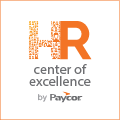
HR Webinars
Live + On-Demand Webinars
Hear from HR industry experts as they cover timely topics and share best practices on everything from recruiting and hiring, to compliance and employee engagement.
Learn more about Paycor’s webinar events throughout the year.
Hear from HR industry experts as they cover timely topics and share best practices on everything from recruiting and hiring, to compliance and employee engagement. Learn more about Paycor’s webinar events throughout the year.
Live Webinar
Compliance Series: Navigating Compliance in a Remote Work World
HRCI & SHRM credit available
Even post-COVID, remote work continues to be a top perk for employees and a way for employers to expand and improve their applicant pool.
2:00pm ET, July 15th, 2025
Live Webinar
Is Your Workplace Violence Prevention Program Preventing Violence?
HRCI & SHRM credit available
“It can’t happen here.” “It won’t happen here.” These are some of the most dangerous assumptions an organization can make.
11:00am ET, July 17th, 2025
Live Webinar
July Virtual Demo
Join us on an exclusive tour of Paycor’s award-winning HR & Payroll Platform. From recruiting, onboarding, and benefits, to career development and retention, learn how Paycor modernizes every aspect of people management and empowers leaders to build winning teams.
2:00pm ET, July 17th, 2025
Live Webinar
Benefits Series: Flex Appeal – Why Customizing Benefits Maximizes Engagement
HRCI & SHRM credit available
One-size-fits-all benefits just don’t cut it anymore. Employees’ expectations are higher than ever, and those expectations change based on their age, job title, career goals, family structure, health needs, and more.
11:00am ET, July 24th, 2025
Live Webinar
Elevate Your Business with Paycor’s Partner+ Program
We know you have questions about the Paycor + Paychex acquisition. Here’s your chance to hear all about our path forward with Paycor’s Partner+ program.
2:00pm ET, July 24th, 2025
Live Webinar
HR Auditing for Proactive Compliance
HRCI & SHRM credit available
In today’s quickly changing regulatory environment, companies face increasing challenges in maintaining compliance, especially concerning employee classification, immigration enforcement, and evolving labor laws.
11:00am ET, July 31st, 2025
Live Webinar
Mid Year Compliance Updates
This webinar will focus on mid-year legislative changes including new provisions from the American Rescue Plan Act and state and local updates.
2:00pm ET, July 31st, 2021
Live Webinar
HR in 2026: Insights and Best Practices
What separates high-performing companies from the rest? We surveyed more than 3,000 business professionals to learn what they are doing differently in HR and employee engagement.
2:00pm ET, August 5th, 2025
Live Webinar
Belonging & Engagement Series: Cultivating Engagement Through Ownership and Belonging
HRCI & SHRM credit available
We all know that engaged employees perform better. But how do managers create true commitment, initiative, and connection? Beyond surveys and slogans, what actions drive engagement?
2:00pm ET, August 12th, 2025
Live Webinar
Compliance Series: ADA: Reasonable Accommodation and the Interactive Process
HRCI & SHRM credit available
The Americans with Disabilities Act (ADA) requires employers to provide reasonable accommodations to employees with disabilities. Do you know what your organization’s responsibilities are under the ADA?
2:00pm ET, August 14th, 2025
Live Webinar
Belonging & Engagement Series: Creating Inclusive Workplaces When DEI Efforts Are Under Fire
HRCI & SHRM credit available
As DEI positions are being eliminated at the federal level and organizations are scaling back on DEI efforts, inclusivity remains non-negotiable.
2:00pm ET, August 19th, 2025
Live Webinar
Belonging & Engagement Series: How to Be an Ally – Why Empathy Fosters Belonging
HRCI & SHRM credit available
In today’s culture, allyship is more important than ever. Best practices are changing rapidly, and it can be difficult for HR, employees, and businesses to keep up.
11:00am ET, August 28th, 2025
Learn valuable tips to help your business thrive.
Stay Up-to-Date With Our HR Newsletter
Learn Valuable Tips to Help Your Business Thrive.

(532 reviews)

(2,065 reviews)









